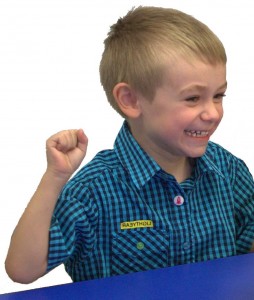
Communication is not just about having the right words or being able to construct a well formed sentence. It is also about how children use their communication skills. Sometimes children with speech and language difficulties and other disabilities are passive communicators. They respond when they are spoken to and say things when they are prompted. To be an effective communicator however children need to know how to initiate communication themselves. They also need to know how to keep an interaction going by taking a number of turns, not just making a single response. Here are some ways you can help your child be an active communicator.
Provide opportunities when your child will need to communicate. As parents we get good at understanding our children, predicting and interpreting what they want and need. If we do this often our children do not need to initiate communication themselves, and this effects the development of communication skills as well as other important things such as independence, persistence, resilience and self help skills.Make sure that your child has plenty of opportunities to need to communicate every day.
In everyday activities such as dressing, bathing and mealtimes, don't provide everything your child needs, rather "forget" some things so that your child needs to communicate this to you. For example you might give your child an empty cup at lunchtime and wait for them to show you they want juice in it. Better still put the milk and juice bottles on the table and see if your child shows you in some way which one they want. They might say the word or they might reach, point or look at the one they want and you can then model the word for them.
Put favourite toys out of reach such as on a shelf or in a clear box where your child can see them but not get them for themselves and if your child wants the item, encourage asking or pointing before giving it to them.
Change routines your child is familiar with and wait to see if they try to correct you. Pretend you made a ‘silly’ mistake.
In favourite games or activities encourage your child to ask for the necessary items needed and to tell you what should happen next:
- When drawing put out the paper and wait for your child to ask for pencils.
- When playing with lego or any other toy, pretend that you do not know what to do and wait for your child to show or tell you.
- When making something familiar in the kitchen together such as toast or a sandwich pretend you do not know what to do, wait and encourage your child to show or tell you what to do
- When playing familiar games stop and wait to see if your child communicates to you that you need to ‘go’ or they want ‘more’.
Conversations are made up of a series of turns. I take a turn, then you take a turn, and then I take another turn. Some children need support to keep their interactions going for more than a single turn. Teaching children how to take turns in games will help them to learn about taking turns when they are talking. A turn can be a gesture, sound, word, sign or pointing to an object, or any combination of these.
Try to structure your play activities so you and your child take turns and are equally active. Once you have taken your turn, pause and wait with anticipation for your child to take another turn. Show them using body language, that you expect a response. Silently count to five before saying or doing anything. Waiting for the child is difficult to do. It is much easier to fill the gap, but if we don't wait, we may miss the child's attempt to take another turn. If we don't expect a response we probably won't get one. Use the turn-taking technique in different situations.
At the end of any activity wait before moving to another activity or situation to see if your child wants more.
- end of meal
- end of bath
- end of game
Here are some ways to help your child learn to take turns.
- Peek-a boo
- Rolling the ball back and forth to your child. As you roll the ball model the word “go” at the same time.
- Play skittles and take turns rolling the ball
- Take turns blowing bubbles
- Take turns stacking blocks or when playing with stacking cups or stacking ring toys
- Push a toy car back and forth
- Take turns with another child, parent or a teddy going down a slide
- Take turns with simple drawing, stamping and sticking activities
- Take turns to turn over cards in a simple matching game
- Take turns to open flaps in a simple book
- Take turns to press pop up toys
Watch to see if your child lets you know they have had enough. Being able to assert yourself when you don't want something is an important communication skill too. Watch for signs then help your child use a simple word or gesture such as "no" or "finished".
Allowing your child to be an active communicator helps them prepare to be effective communicators and to develop independence, assertiveness and self esteem.
If you have concerns about your child's speech or language skills the Talking Matters website has information about these skills and checklists to see how your child is developing for their age. We provide individualised assessments and therapy for children with speech, language and learning difficulties and other disabilities. Our aim is to help parents help their child reach their potential. See how we can help or contact a speech pathologist in your local area.
Related Blog Posts
If you liked this post you may also like:
Self esteem
Procedures 12 ways
Tantrums and meltdowns 101
Summer fun!



